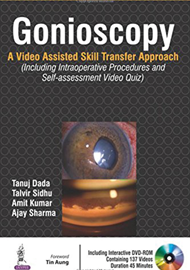Gonioscopy is a critical part of the eye examination, a challenging technique to learn and although drawings and photographs are helpful, videos that demonstrate the technique and findings are particularly valuable. Interpretation beyond merely identifying whether there is a closed or open angle can be perplexing to the novice.
This product comprises a slim volume, listing the titles of the 137 videos of goniscopic views that can be accessed on the accompanying DVD-ROM. Each video includes a brief audio description of the salient features to be noted and the hardback booklet that accompanies the DVD-ROM shows a small still image and the transcription of the commentary for each video.
The entire video lasts 45 minutes and is separated into very short clips encompassing a range of anterior angle presentations. These include developmental anomalies, open angle glaucoma, angle closure glaucoma, secondary glaucoma, intraoperative techniques and 26 videos that allow a self-assessment quiz. The image quality for each video clip is reasonably clear and stable, despite being live views, and although there is no zoom facility, one can freeze the action, or just review the brief excerpts until confident about the features. Some of the videos also show the change in appearance when indentation is employed to improve the view of the angle.
Many ophthalmic units have the facility to document their own cases and create a stock library of equivalent video clips of gonioscopic views that could be used as departmental teaching material. This team has made some of their library available to those without locally produced material. It provides a useful tool for learning and improving one’s knowledge of the anterior chamber and the angle anomalies, both congenital and acquired.
It does assume that one is familiar with the structure of the anterior chamber angle, the typical orientation / plan of the angle and the technique employed accessing and obtaining a view of the angle. This product is probably best used alongside a more comprehensive textbook on the subject. There is no specific reference list. It is disappointing that the videos can only be viewed on a computer and not in a DVD player as this limited the accessibility, and the operating system needs to be Windows Vista or above, however, this is probably a minor detail for most practitioners.
Trainee ophthalmologists, optometrists, specialist glaucoma nurses and ophthalmic imaging team members wishing to improve their recognition skills in gonioscopy are likely to find this a useful aide memoire.




